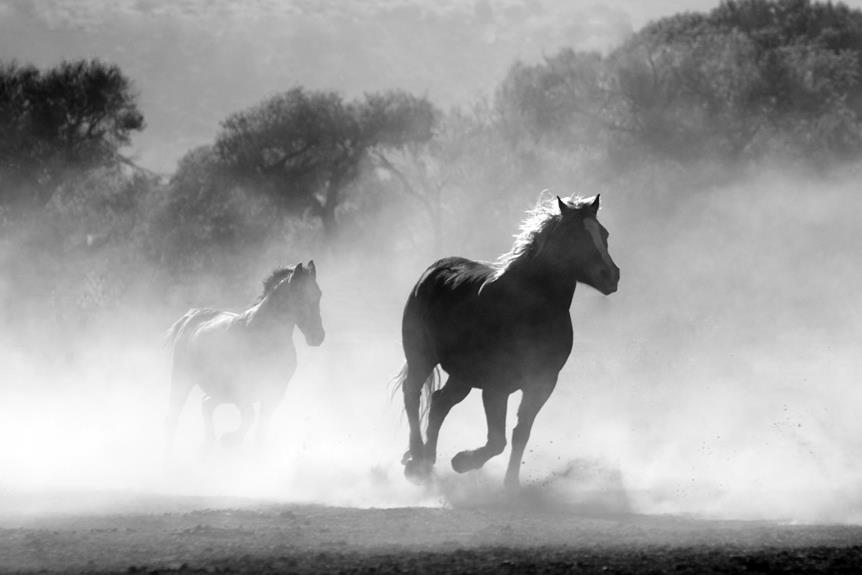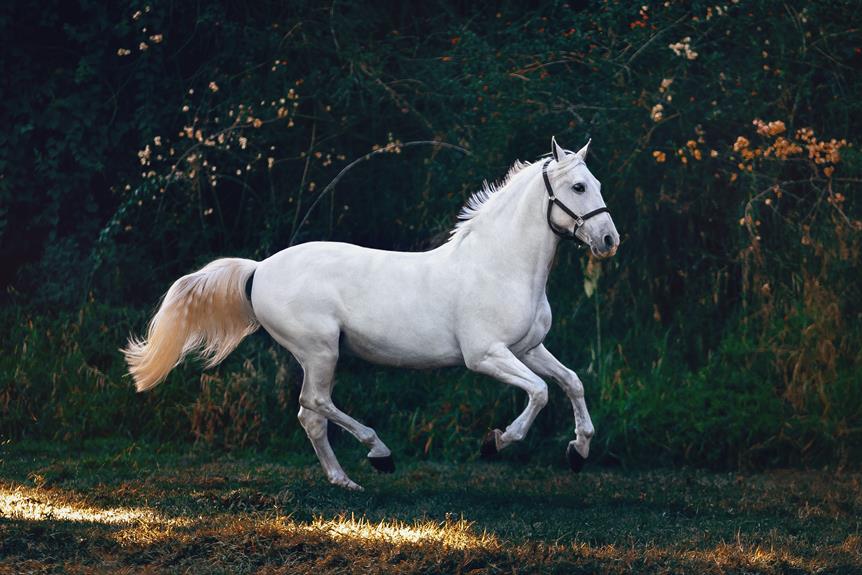Picture this: you're ready to saddle up and hit the trails on your trusty steed, but before you can even think about mounting, you need to consider a crucial factor – how much it's going to cost to feed your horse.
Now, I know what you're thinking, 'Here we go again with the never-ending expenses!' But hold your horses, because understanding the cost of horse feed is essential for responsible horse ownership.
The truth is, there's more to it than simply tossing some hay in the stable. So, saddle up and let's explore the world of horse feed costs, because trust me, it's worth knowing.
Key Takeaways
- Pasture maintenance and utilization can significantly reduce horse feed costs.
- Grass hay is a budget-friendly option for feeding horses, with costs ranging from $2 to $4 per day.
- Mixed grass/legume hay provides a balanced diet with higher protein content and can cost around $4 to $6 per day.
- Premium legume hays and specialized diets for specific dietary needs can be high-cost options, ranging from $15 to $25 per bale and $10 to $15 per day, respectively.
Factors Affecting Horse Feed Costs
Factors that impact the cost of feeding a horse include pasture maintenance expenses, hay supplementation, and the formulation and quality of feeds. These factors have a direct influence on the overall costs associated with feeding horses.
Starting with pasture maintenance expenses, they can range from $100 to $300 per year for a single horse on pasture, considering costs for fertilizer, labor, and fuel.
When it comes to hay supplementation, the type of hay chosen plays a significant role in the cost to feed a horse. Different types of hay, such as grass hay, mixed grass/legume hay, and legume hay, come with varying prices. It's crucial to calculate hay costs based on feeding a 1000-pound horse at 1.5% of its body weight per day. Price variations due to region, forage quality, and other factors should also be considered.
Additionally, the formulation and quality of feeds impact the cost of horse feed. Standard and premium horse feeds have different costs per pound, and yearly costs for feeding a 1000-pound horse at different activity levels should be taken into account.
It's important to note that economic pressures can lead to higher hay prices, which ultimately impact the overall cost of feeding horses. By considering these factors, horse owners can make informed decisions about their horse feed expenses.
Budget-Friendly Horse Feed Options
When looking for affordable options to feed your horse, consider hay as a cost-effective choice. Hay prices can range from $100 to $300 per year for a single horse on pasture, depending on the type of hay and region.
Here are three budget-friendly horse feed options to consider:
- Grass Hay: Grass hay is a common and economical choice for horses. It provides the necessary forage and can be found at a reasonable cost. You can feed your horse on grass hay for as little as $2 to $4 per day, depending on the size and nutritional needs of your horse.
- Mixed Grass/Legume Hay: This type of hay combines the benefits of grass and legume forages, providing a balanced diet for your horse. It usually costs a bit more than grass hay, but it offers higher protein content and additional nutrients. Depending on the quality and availability in your area, mixed grass/legume hay can range from $4 to $6 per day.
- Pasture: Utilizing pasture as a feed option can significantly reduce your horse's feed costs. If you have access to good quality pasture, your horse may be able to graze for a large part of the year, minimizing the need for additional hay or feed. However, it's important to ensure that the pasture is well-maintained and provides adequate nutrition for your horse.
Moderate-Cost Horse Feed Options
Consider grass hay, mixed grass/legume hay, and standard horse feeds as moderate-cost options for feeding your horse. These options provide essential nutrients while being more affordable compared to other feed choices. Here is a table summarizing the estimated monthly cost, pounds of hay per day, forage per day, and cost per pound for each option:
| Feed Option | Monthly Cost | Pounds of Hay per Day | Forage per Day | Cost per Pound |
|---|---|---|---|---|
| Grass Hay | $150 | 20 | 25 | $0.15 |
| Mixed Grass/Legume Hay | $200 | 15 | 20 | $0.17 |
| Standard Horse Feeds | $250 | – | – | $0.50 |
It's important to note that the cost per pound for standard horse feeds is higher due to the added convenience and nutritional content they offer. When deciding on the best option for your horse, consider factors such as their special needs, body weight, and access to pasture. While grass hay and mixed grass/legume hay can provide good quality forage, standard horse feeds can be supplemented with additional nutrients to meet specific requirements. Remember to calculate feed costs based on your horse's individual needs and activity levels. By carefully evaluating your options, you can find a moderate-cost feed that meets your horse's nutritional needs without breaking the bank.
High-Cost Horse Feed Options
High-cost horse feed options can include premium legume hays and concentrate feeds with increased nutrient content, resulting in a higher price. When it comes to ensuring the quality of your horse's diet, costs associated with high-cost horse feed options can vary depending on your horse's specific needs.
So, how much does it cost to feed a horse with these high-cost options? Here are three things to consider:
- Premium Legume Hays: High-quality hay is essential for a healthy horse. Premium legume hays, such as alfalfa or clover, offer increased nutrient content, but they come at a higher cost compared to standard hays. Expect to pay anywhere from $15 to $25 per bale, depending on the region and quality.
- Concentrate Feeds: Premium concentrate feeds, which have higher quality and nutrient levels, can also drive up costs. These feeds often contain additives like vitamins, minerals, pre- and probiotics, and protein. They provide a balanced diet but can cost anywhere from $20 to $40 per bag, depending on the brand and composition.
- Specialized Diets: Feeding horses with specific dietary needs, such as sport competitors, senior horses, broodmares, or growing foals, may require a higher budget. These specialized diets can range from $10 to $15 per day, ensuring your horse gets the necessary nutrients for optimal performance and health.
Summary: Finding the Right Balance for Your Horse's Diet
To ensure your horse's diet is properly balanced, it's important to find the right combination of high-cost horse feed options and standard feeds. Balancing your horse's diet is crucial for maintaining good nutrition and meeting their special dietary needs. The cost of feeding a horse can vary depending on factors such as forage costs, concentrate costs, and additional costs of supplementing standard feeds.
Consider the following table to help you make informed decisions about finding the right balance for your horse's diet:
| Factors to Consider | Examples |
|——————–|———-|
| Forage Costs | – Pasture maintenance expenses
- Yearly costs for grazing
- Types of hay and their prices
- Premium prices for nutrient-rich legume hays |
| Calculating Hay Costs | – Daily and yearly costs for different types of hay
- Price variations based on region and forage quality
- Comparison between square and round bales |
| Evaluating Concentrate Costs | – Wide variety of feed formulations and qualities
- Recommended feeding amounts for premium feeds
- Yearly costs for feeding based on horse's activity level |
| Additional Costs of Supplementing Standard Feeds | – Added nutrients and benefits of premium feeds
- Examples of additional costs for supplementing standard feeds
- Importance of considering overall costs when choosing feeds |
Frequently Asked Questions
How Much Does It Cost per Month to Feed a Horse?
On average, it costs around $100 to $300 per month to feed a horse. This includes hay, grain, and supplements. The cost can vary based on the horse's size, feeding requirements, and whether or not they have access to pasture.
How Much Does It Cost to Keep a Horse per Month?
To keep a horse per month, you need to consider factors like feeding schedule, types of horse feed, nutritional requirements, and cost-effective options. Also, remember to budget for supplements, special dietary needs, grazing, and seasonal variations in feeding costs.
How Long Does a 50 Lb Bag of Horse Feed Last?
A 50 lb bag of horse feed can last around 3-4 weeks, depending on your horse's weight and activity level. Make sure to consider their nutritional needs, storage options, and adjust feed quantities accordingly.
How Expensive Is It to Maintain a Horse?
Maintaining a horse can be expensive, but there are ways to manage costs. Factors like diet, pasture access, and feeding practices affect expenses. Consider budget-friendly options, like DIY feed or balancing nutrition on a tight budget.
Conclusion
In conclusion, the cost of feeding a horse can vary depending on factors such as pasture maintenance, hay supplementation, and the type of hay being fed. Additional expenses for concentrate feeds, supplements, boarding, farrier services, and grooming supplies should also be considered.
The overall cost can range from less than $5.00 per day for a basic diet to $10-15.00 per day for horses with specific needs. It's important to find the right balance for your horse's diet while considering your budget.



0 Comments